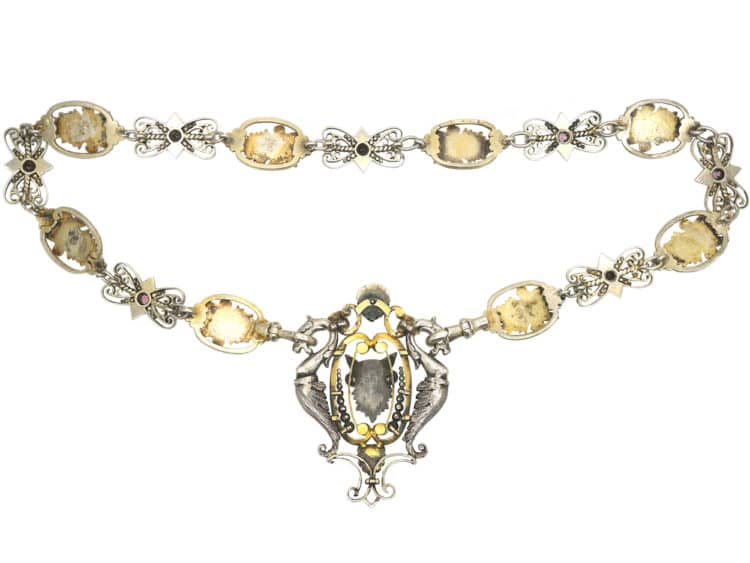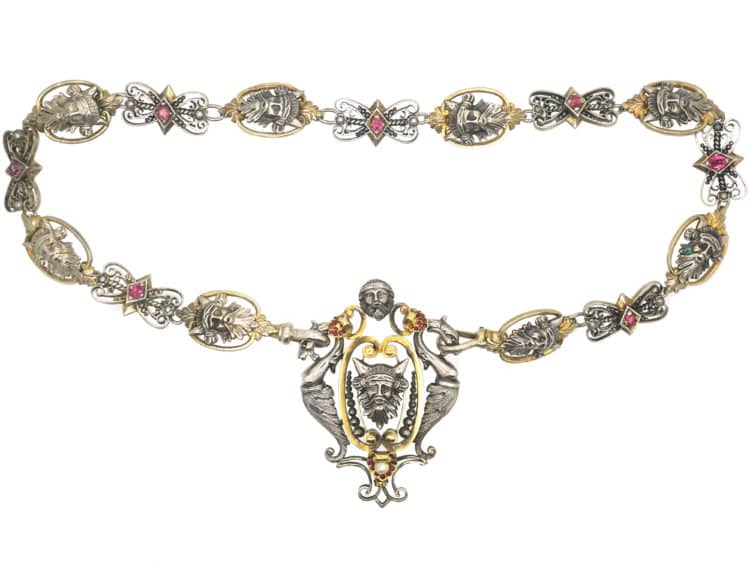Are you curious about the beauty of Renaissance Revival Jewelry? Would you like to learn more about its styles and origins? This article will provide an overview of Renaissance Revival Jewelry, including the unique styles and techniques used to craft it. You’ll also learn about the history of this type of jewelry and how it has evolved over the years. So, let’s explore the beauty of Renaissance Revival Jewelry!
1. History of Renaissance Revival Jewelry
The Renaissance period of the 14th to 17th centuries was a time of great artistic and cultural development. During this period, jewelry was crafted from precious metals such as gold and silver and adorned with gemstones and pearls. The ornate designs of Renaissance Revival jewelry draw inspiration from this period and have become a popular choice for many modern wearers.
Renaissance Revival jewelry was first popularized in the 19th century, as part of the Romanticism movement. During this time, people looked to the past and the ideals of the Renaissance period to find inspiration for their jewelry designs. The jewelry of this period was heavily influenced by the works of the Italian Renaissance and often featured intricate designs with religious motifs and symbols.
In the 20th century, Renaissance Revival jewelry was rediscovered and popularized by the Art Nouveau movement. In the mid-20th century, artisans and designers began to experiment with the style, creating pieces that incorporated modern elements with traditional Renaissance designs. Today, Renaissance Revival jewelry is still a popular choice for many, with pieces ranging from delicate and ornate to bold and modern.
The beauty of Renaissance Revival jewelry lies in its intricate designs and timeless style. Whether you are looking for a classic piece with religious motifs or a modern take on the style, there is something for everyone.

2. Materials Used in Renaissance Revival Jewelry
Renaissance revival jewelry is a popular style of jewelry that is inspired by the Renaissance period. This style of jewelry is characterized by intricate designs and bold colors. It is often crafted from precious metals such as gold and silver, and may include semi-precious stones such as emeralds, rubies, and sapphires.
In addition to precious metals and stones, Renaissance revival jewelry often uses a variety of other materials. These materials include enamel, glass, ivory, and wood. Enamel is a type of glass-like material that is often used to add color and intricate designs to jewelry. Glass is also used to create colorful beads and shapes. Ivory is often used to create detailed designs and motifs, while wood is used to create unique shapes and figures.
The beauty of Renaissance revival jewelry lies in its use of a variety of different materials. These materials work together to create beautiful and unique pieces that capture the spirit of the Renaissance period.

3. Popular Design Elements of Renaissance Revival Jewelry
Renaissance Revival jewelry is a popular style of jewelry that originated in Europe during the mid-19th century. This style of jewelry combines elements of historical jewel designs from the Renaissance period with modern designs. Popular design elements of Renaissance Revival jewelry include intricate metalwork, gemstones, and enameling.
Intricate metalwork is a hallmark of Renaissance Revival jewelry. This type of jewelry often features intricate patterns and designs made from gold, silver, and other metals. The designs often feature motifs from the Renaissance period, such as fleur-de-lis, acanthus leaves, and laurel wreaths.
Gemstones are also popular design elements in Renaissance Revival jewelry. Popular gemstones used in this style of jewelry include diamonds, rubies, sapphires, and emeralds. The stones are often set in intricate metalwork, giving the jewelry a unique look.
Enameling is a popular technique used in Renaissance Revival jewelry. This technique is used to create colorful designs on the jewelry. The enameling technique involves applying a thin layer of colored glass to the metal, which is then fired in a kiln. This technique can create beautiful designs that add color and interest to the jewelry.
4. Notable Makers of Renaissance Revival Jewelry
The Renaissance Revival period of jewelry making is a distinct style that saw a resurgence in popularity in the late 19th century. It is characterized by intricate and ornate designs that blend elements of medieval, classical and renaissance styles. Some of the most notable makers of Renaissance Revival jewelry include:
- Garrard & Co.: Founded in 1735, Garrard & Co. is the oldest and most distinguished jewelry house in the world. Their Renaissance Revival pieces are known for their intricate details and exquisite craftsmanship.
- Cartier: Founded in 1847, Cartier is one of the most renowned jewelers in the world. Their Renaissance Revival pieces feature bold designs with intricate details.
- Boucheron: Founded in 1858, Boucheron is a French jewelry house known for their exquisite Renaissance Revival pieces. Their designs often feature abstract motifs and enamel work.
- Tiffany & Co.: Founded in 1837, Tiffany & Co. is one of the most iconic jewelry houses in the world. Their Renaissance Revival pieces are known for their classic designs and exquisite craftsmanship.
These renowned jewelers have created some of the most beautiful and iconic pieces of Renaissance Revival jewelry. Their pieces are still highly sought after and can be found in museums and galleries around the world.

5. How to Identify Authentic Renaissance Revival Jewelry
Renaissance Revival jewelry is a beautiful and timeless style that has been popular for over a century. However, it can be difficult to distinguish between authentic and imitation pieces. Here are some tips to help you identify genuine Renaissance Revival jewelry:
- Check the materials: Renaissance Revival jewelry is typically made from gold, silver, or platinum and features precious gemstones such as diamonds, rubies, and sapphires. If the jewelry is made from cheaper materials or features synthetic stones, it is likely not authentic.
- Look for intricate designs: Renaissance Revival jewelry is known for its elaborate designs, which often include detailed engravings, filigree work, and intricate patterns. If the piece is plain or lacks intricate details, it may not be genuine.
- Research the maker: Many Renaissance Revival jewelry pieces were made by famous designers such as Castellani, Giuliano, and Fontana. Researching the maker can help you determine the authenticity of the piece.
- Consider the era: Renaissance Revival jewelry was popular during the late 19th and early 20th centuries. If the piece is dated outside of this era, it may not be authentic.
- Get an appraisal: If you are still unsure about the authenticity of your Renaissance Revival jewelry, consider getting it appraised by a professional. They can provide you with a detailed analysis of the materials, maker, and value of the piece.
By following these tips, you can ensure that your Renaissance Revival jewelry is authentic and valuable. Remember, investing in genuine pieces is always
6. Care and Maintenance of Renaissance Revival Jewelry
Renaissance Revival jewelry is a timeless and elegant form of jewelry that will last for generations if properly cared for. To ensure your jewelry remains in pristine condition, it is important to follow a few simple steps for proper care and maintenance.
- Store your jewelry in a cool, dry place away from direct sunlight. It is best to keep your jewelry in a separate box or pouch to avoid it being scratched or tangled with other items.
- Periodically, inspect your jewelry for any loose or missing stones. If any stones are missing, contact a professional jeweler to have them repaired or replaced.
- Clean your jewelry regularly with a soft, lint-free cloth. Avoid using any harsh chemicals or abrasive cloths, as these can damage the delicate metal and stones.
- Have your jewelry professionally checked and cleaned every 6-12 months. This will ensure all settings and stones are secure and free of dirt and grime.
- Avoid wearing your jewelry when swimming, showering, exercising or gardening. Chlorine, sweat and dirt can damage the metal and stones.
By following these simple steps for care and maintenance, you can ensure that your Renaissance Revival jewelry will remain beautiful for generations to come.

Conclusion :
The Renaissance Revival period in jewelry design is a testament to the enduring allure of the Renaissance era. This style, characterized by its intricate designs, use of enamel, and incorporation of mythological and historical motifs, offers both aesthetic appeal and a rich connection to history. Whether you’re a collector, a history enthusiast, or someone who appreciates fine craftsmanship, Renaissance Revival jewelry provides a unique blend of beauty and historical significance.
